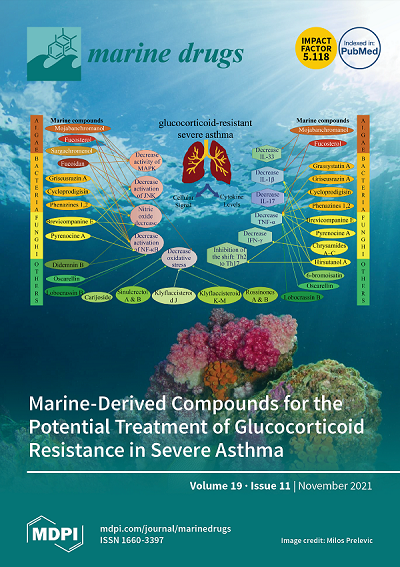Light Spectra, a Promising Tool to Modulate Ulva lacinulata Productivity and Composition
IF 4.9
2区 医学
Q1 CHEMISTRY, MEDICINAL
引用次数: 0
Abstract
Light quality is a key factor affecting algal growth and biomass composition, particularly pigments such as carotenoids, known for their antioxidant properties. Light-emitting diodes (LEDs) are becoming a cost-effective solution for indoor seaweed production when compared to fluorescent bulbs, allowing full control of the light spectra. However, knowledge of its effects on Ulva biomass production is still scarce. In this study, we investigated the effects of LEDs on the phenotype of an Ulva lacinulata strain, collected on the Northern Portuguese coast. Effects of white (W), green (G), red (R), and blue (B) LEDs were evaluated for growth (fresh weight and area), photosynthetic activity, sporulation, and content of pigments and antioxidant compounds. The results showed that there were no significant differences in terms of fresh weight accumulation and reduced sporulation among the tested LEDs, while W light induced the highest expansion rate. Under G, U. lacinulata attained a quicker photoacclimation, and the highest content of pigments and total antioxidant activity; but with R and W, antioxidant compounds against the specific radicals O2•− and •NO were produced in a higher content when compared to other LEDs. Altogether, this study demonstrated that it is possible to modulate the bioactive properties of U. lacinulata by using W, R, and G light, opening the path to the production of biomass tailored for specific nutraceutical applications.光谱--调节 Ulva lacinulata 生产率和组成的有效工具
光质是影响藻类生长和生物量组成的关键因素,尤其是类胡萝卜素等色素,它们具有抗氧化特性。与荧光灯相比,发光二极管(LED)可以完全控制光的光谱,正在成为室内海藻生产的一种经济有效的解决方案。然而,有关 LED 对莼菜生物量生产的影响的知识仍然很少。在这项研究中,我们调查了 LED 对在葡萄牙北部海岸采集的一种 Ulva lacinulata 菌株表型的影响。我们评估了白光(W)、绿光(G)、红光(R)和蓝光(B)LED对生长(鲜重和面积)、光合作用活性、孢子以及色素和抗氧化化合物含量的影响。结果表明,在鲜重积累和孢子数量减少方面,受试 LED 之间没有显著差异,而 W 光诱导的扩展率最高。在 G 光下,U. lacinulata 的光适应性较快,色素含量和总抗氧化活性最高;但在 R 和 W 光下,与其他 LED 相比,U. lacinulata 产生的针对特定自由基 O2-- 和 -NO 的抗氧化化合物含量较高。总之,这项研究表明,使用 W 光、R 光和 G 光可以调节 U. lacinulata 的生物活性特性,为生产适合特定营养保健应用的生物质开辟了道路。
本文章由计算机程序翻译,如有差异,请以英文原文为准。
求助全文
约1分钟内获得全文
求助全文
来源期刊

Marine Drugs
医学-医药化学
CiteScore
9.60
自引率
14.80%
发文量
671
审稿时长
1 months
期刊介绍:
Marine Drugs (ISSN 1660-3397) publishes reviews, regular research papers and short notes on the research, development and production of drugs from the sea. Our aim is to encourage scientists to publish their experimental and theoretical research in as much detail as possible, particularly synthetic procedures and characterization information for bioactive compounds. There is no restriction on the length of the experimental section.
 求助内容:
求助内容: 应助结果提醒方式:
应助结果提醒方式:


